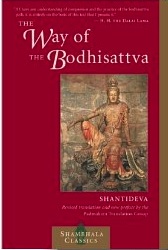The Way of the Bodhisattva by Shantideva

 The Way of the Boddhisattva, referred to as the Bodhicaryavatara or Bodhisattvacharyavatara, is a classic Mahayana text written in the eighth century by Shantideva, a monk at the famous Buddhist university Nalanda in India. It is a practice text, designed to guide one through the stages of Mahayana practice, and the development of bodhicitta (the 'mind of enlightenment', or 'awakening mind.') It is considered one of the best expressions of the Madhyamika, or 'wisdom tradition', school of Buddhism, and is particularly honored within Tibetan Buddhism. The Dalai Lama has said, "If I have any understanding of compassion and the bodhisattva path, it all comes from studying this text."
The Way of the Boddhisattva, referred to as the Bodhicaryavatara or Bodhisattvacharyavatara, is a classic Mahayana text written in the eighth century by Shantideva, a monk at the famous Buddhist university Nalanda in India. It is a practice text, designed to guide one through the stages of Mahayana practice, and the development of bodhicitta (the 'mind of enlightenment', or 'awakening mind.') It is considered one of the best expressions of the Madhyamika, or 'wisdom tradition', school of Buddhism, and is particularly honored within Tibetan Buddhism. The Dalai Lama has said, "If I have any understanding of compassion and the bodhisattva path, it all comes from studying this text."The Way of the Bodhisattva contains 10 chapters, and is often considered to have three main sections. The first three chapters focus on awakening bodhicitta in the mind, including purifying one's mind of negativity, and cultivating motivation to awaken for the sake of others. The next three chapters offer instructions on how to maintain bodhicitta, including how to cultivate conscientiousness, vigilance, and patience in both thought and action. This is followed by three chapters focused on deepening bodhicitta, including through meditation and the wisdom of emptiness, or ultimate bodhicitta. The tenth and final chapter is a prayer of dedication.
The text is composed of verses, such as this one from the first chapter, which compares the power of bodhicitta arising in our usually ego-based minds to a lightening flash in a dark night:
Just as on a dark night black with clouds,
The sudden lightening glares and all is clearly shown,
Likewise rarely, through the Buddhas’ power,
Virtuous thoughts rise, brief and transient, in the world.
(Verse 1.5 – all translations in this article taken from Shambhala’s new translation, linked to at the end of this article)
These thoughts form the basis for practice, Shantideva tells us, as we seek to practice in order to strengthen the roots of these thoughts within our mind, while we also work to weed out negative, ego-based thoughts.
Bodhicitta is associated with compassion, culminating in the bodhisattva vow to forsake enlightenment in order to practice for the enlightenment of all beings. Shantideva speaks to the motivation behind this vow in chapter 8:
All the joy the world contains
Has come through wishing happiness for others.
All the misery the world contains
Has come through wanting pleasure for oneself.
(8.129)
Through cultivating the true wish for others’ happiness and awakening, we in fact awaken it within ourselves. This is part of the 'relative' level of bodhicitta - the level on which we seek to both think and act for the welfare of others. 'Ultimate' bodhicitta is the topic of the next chapter, Wisdom, and forms the basis for what is often called the wisdom tradition.
Ultimate bodhicitta is the wisdom of emptiness that transcends philosophy – the realization of the non-dual nature of all that is. When we abide in ultimate bodhicitta, our compassion arises from true understanding that all that happens to us happens to all, and visa versa. From the perspective of ultimate bodhicitta, all truly is one, and we no longer need to 'weed' our mind, because everything that arises from our realization is naturally in alignment. The compassion that expresses itself through us is grounded in our knowledge of emptiness – the essential sameness of us all.
The following two verses elucidate relative and ultimate bodhicitta:
Relative and ultimate,
These the two truths are declared to be.
The ultimate is not within the reach of the intellect,
For intellect is said to be the relative.
(9.2)
When something and its nonexistence
Both are absent from before the mind,
No other option does the latter have:
It comes to perfect rest, from concepts free.
(9.34)
To study this text in more depth, join me in the forum for an ongoing thread looking at specific passages (a kind of online study group!)
You Should Also Read:
Book and Product Reviews
Into the Heart of Life

Related Articles
Editor's Picks Articles
Top Ten Articles
Previous Features
Site Map
Follow @mommymystic
Tweet
Content copyright © 2023 by Lisa Erickson. All rights reserved.
This content was written by Lisa Erickson. If you wish to use this content in any manner, you need written permission. Contact Lisa Erickson for details.


